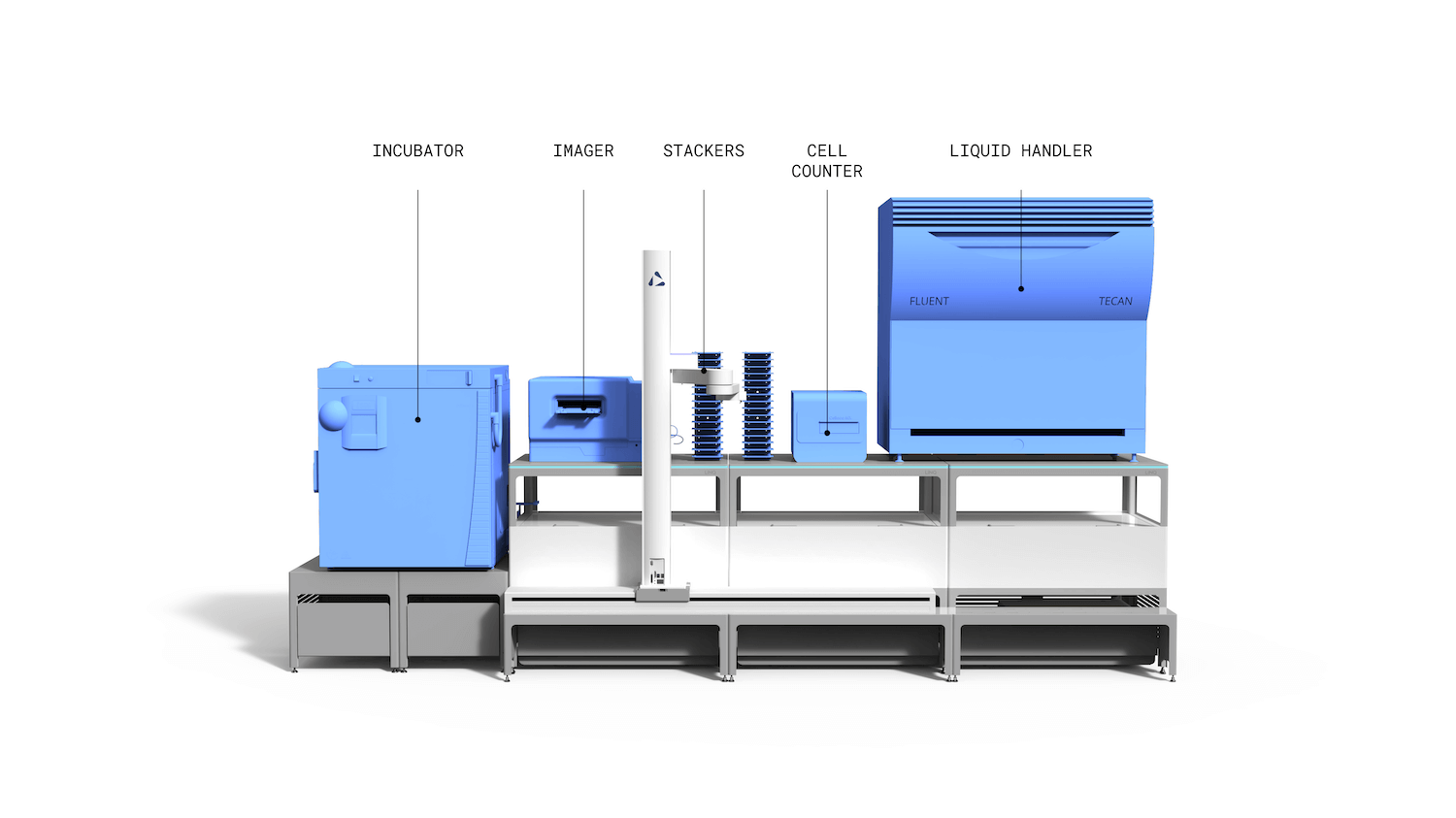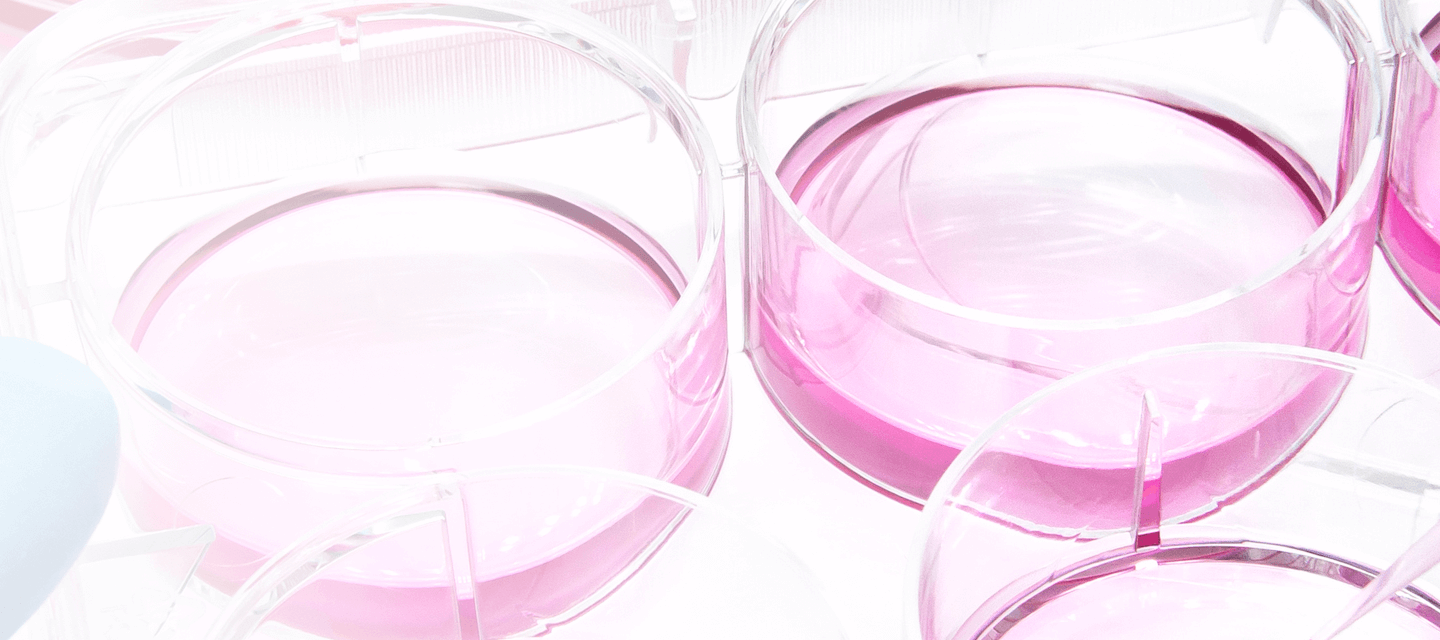Free scientists from manual tasks
At the core of all tissue culture operations are the processes involved in keeping cells healthy. Feeding and nurturing cells is a daily, repetitive chore for scientists working with any kind of mammalian cell line.
Unfortunately, biology simply doesn’t adhere to our working days. That means constant maintenance of cells outside of normal working hours – and especially over weekends. Often, long-term experiments are designed around avoiding scientists having to work antisocial hours – compromising the effectiveness of the experiments – or lab workers are forced to work out of hours.
This is why applying open, integrated automation to some of these standard operations is critical to unlocking the full potential of labs and freeing up scientists from low-value tasks like media exchange and passaging.
Our solution: Open, integrated automation

Increase operational lab time 500%
Applying open, integrated automation to the processes of tending to cells in most longer-term cell culture experiments could increase lab utilisation and experimental time 5x or greater.
A system like this also requires some specialised tooling to complete the system:
Tilting: Replicating motions that scientists carry out naturally to remove media from larger vessels or treat cells with dissociation reagents requires mechanical operations. Our universal tilting position can be applied to liquid handling platforms to enable full media transfer and cell recovery from any kind of SBS labware.
Media: A large amount of media can be required even for small numbers of plates/flasks. Automata provides a media handling unit that keeps the media chilled until required. It is then warmed on delivery to the platform just in time for use in a process.
Containment: Automata has partnered with clean air specialists to develop modular containment solutions from HEPA product protection to full class 2 biosafety. Openness is central to the design of the LINQ platform, so any solution will allow walk-up access to devices.
Get in touch and find out how we can help your lab automate
Is Automata right for my cell culture lab?
Here are a few answers to some frequently asked questions
Human or animal-derived adherent and suspension cells (although we also work with systems for bacteria and yeast culture).
Capacity is typically defined by the size of the incubators, and the systems can be expanded in a modular way to add greater capacity. The smallest unit is designed to accommodate 42 96-well plates or 34 6-well plates. The top-end capacity is mostly limited by space and system bottlenecks and will be established as part of the development process.
Yes. In the simplest form, settled suspension cells growing in 96-well plates can be handled with the addition of a centrifuge. At larger scales, shaking incubators can be integrated to facilitate the use of shaken cultures.
It is possible to build your own specific analytical capabilities around the central cell maintenance functions by adding required devices in a modular way. This can be expanded as required.
Media can be loaded in bottles or bags into a refrigerator. This means that the system can be specified to handle larger volumes of media, if required. Media is pumped to the deck of the system and warmed just in time for use.
All labware must be SBS footprint. Typical labware for this application are 96-, 48-, 24-, 6- and 1-well plates. It is also possible to run Greiner Autoflasks.
At the core of all Automata cell biology platforms is the capabilities for media exchange – the most consistent set of processes in maintaining cell lines. This can be a simple configuration for just this activity, both in and out of working hours, giving immediate support for keeping cell cultures happy.
The platform can then easily be expanded with additional capabilities as and when required to extend out the possible workflows.
Automation within a laboratory setting simply refers to systems where machines do the majority of the work vs. humans. It can come in many forms and levels of advancement, from none – where all tasks are conducted manually – to full automation.
LINQ facilitates fully automated end-to-end workflows, which means full cell culture workflows can be conducted using digital and robotic connections. With this method, human interactions are significantly reduced, with scientists often only needing to prepare and load consumables and reagents before leaving the system to complete the workflow.
In cell culture benchtop automation is common. For example, filling and dispensing cell suspensions with machines like the Sartorius Fill-It.
LINQ can connect fully workflows and have them operate automatically, going steps beyond simple benchtop automation.
Automation is the quickest way for cell culture labs to free scientists from labour-intensive tasks and antisocial working hours.
Automated workflows can operate without restriction or breaks, increasing throughput while allowing scientists walkway time for more value-added tasks.
It’s also the best way to scale cell biology labs as it allows for improved consistency, repeatability and traceability.
Automated cell culture labs allow instruments to work independently or with minimal human interaction, but the extent to which you choose to automate is up to you.
Individual workcells or entire workflows can be automated with LINQ.
When you work with us we’ll discuss your goals, your current and desired set-up, and any future aspirations or considerations that could affect your automation journey. From there, we’ll design the system you want – for any or many workcells, or full workflows.
With LINQ lab instrumentation can work in parallel, equipment isn’t lost to automation (use it how and when you need) and space is maximised.
The repetitive passaging, monitoring for health and growth, and maintenance of appropriate culture conditions can be extremely tedious, often requiring skilled scientists to be in the lab during the evening or over the weekend.
Automated tissue/cell culture systems are gaining popularity because they have the potential to overcome the drawbacks of manual cell culture by improving reliability and scalability, and by enabling the redeployment of skilled staff.
There are five techniques widely employed for culturing single cells:
- Filter–paper raft nurse
- Petri dish planting
- Micro-chamber
- Nurse callus
- Micro droplet
Cell culture refers to the removal of cells from an animal or plant and their subsequent growth in a favourable artificial environment. The cells may be removed from tissue directly and disaggregated by enzymatic or mechanical means before cultivation, or they may be derived from a cell line or cell strain that has already been established.
Automation within a laboratory setting simply refers to systems where machines do the majority of the work vs. humans.
Automation features in both genomics and cell biology labs.
In cytology and cytopathology, things like slide preparation, image acquisition and image analysis can be automated.
Get in touch if you have a cytology/cytopathology lab that could benefit from automation.
